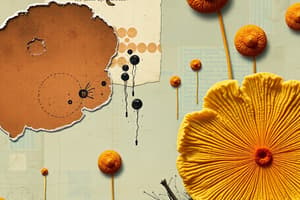Podcast
Questions and Answers
What is the main characteristic of fungal cell walls?
What is the main characteristic of fungal cell walls?
- Made of peptidoglycan
- Composed of a polysaccharide matrix with a glycoprotein and mannan-rich outer layer (correct)
- Made of cellulose
- Consists of a lipid bilayer
Which of the following fungi is an exception to the general characteristic of being multicellular?
Which of the following fungi is an exception to the general characteristic of being multicellular?
- Bridgeoporus nobilissimus
- Yeast (correct)
- Mycorrhizae
- Coprinus spp.
What is the term for the relationship between a fungus and another organism that is mutually beneficial?
What is the term for the relationship between a fungus and another organism that is mutually beneficial?
- Parasitism
- Symbiosis (correct)
- Saprophytism
- Mycorrhizae
What is the name of the fungal filament?
What is the name of the fungal filament?
What is the name of the fungus that has a mutually beneficial relationship with algae or cyanobacteria?
What is the name of the fungus that has a mutually beneficial relationship with algae or cyanobacteria?
What is the term for the separation between nuclei in fungal hyphae?
What is the term for the separation between nuclei in fungal hyphae?
Which of the following is NOT a characteristic of fungal morphology?
Which of the following is NOT a characteristic of fungal morphology?
What is the term for fungi that feed on dead tissue and organic waste?
What is the term for fungi that feed on dead tissue and organic waste?
What is special about the growth of dimorphic fungi like Candida albicans?
What is special about the growth of dimorphic fungi like Candida albicans?
What is the importance of the ability of Candida albicans to transition between yeast and filamentous forms?
What is the importance of the ability of Candida albicans to transition between yeast and filamentous forms?
What is the characteristic of the nuclei in the hyphae of mushroom filaments?
What is the characteristic of the nuclei in the hyphae of mushroom filaments?
What triggers the differentiation of fungal cells into gametes in budding yeast?
What triggers the differentiation of fungal cells into gametes in budding yeast?
What is the diploid stage in the life cycle of budding yeast?
What is the diploid stage in the life cycle of budding yeast?
What happens to diploid yeast cells when nutritional conditions become unfavorable?
What happens to diploid yeast cells when nutritional conditions become unfavorable?
What is the purpose of lovastatin?
What is the purpose of lovastatin?
What is the common name for the microbe that is eaten by humans?
What is the common name for the microbe that is eaten by humans?
Flashcards are hidden until you start studying
Study Notes
What are Fungi?
- Eukaryotic, mostly multicellular, with the exception of yeast
- Heterotrophs, obtaining carbon and energy from other organisms
- Diverse group, with 99,000 known species
Fungal Diversity
- Range from single-celled yeast (e.g., Saccharomyces cerevisiae) to multicellular bracket fungi (e.g., Bridgeoporus nobilissimus)
- Size range: 5-10 microns in diameter (yeast) to 1 meter in diameter (bracket fungus)
Nutritional Modes of Fungi
- Saprophytes or saprobes: feed on dead tissue and organic waste
- Symbionts: mutually beneficial relationships with other organisms (e.g., mycorrhizae, lichens)
- Parasites: feed on living tissue of host, causing disease
Fungal Cell Structure
- Characteristic cell envelope: cell wall, cell membrane, and organelles
- Cell wall: chitin/glucan polysaccharide matrix with glycoprotein and mannan-rich outer layer
- Cell membrane: phospholipid bilayer
- Organelles: nucleus, mitochondria, endoplasmic reticulum, Golgi, and vacuole
Morphological Characteristics of Fungi
- Most fungi are filamentous (hyphae), with yeast being the exception
- Filamentous fungi (mold form): hypha, mycelium, and fruiting body
- Hypha: a fungal filament
- Mycelium: a collection of hyphae
- Fruiting body: contains spores for reproduction
Morphological Characteristics of Fungi (continued)
- Septate: separation between nuclei with septal pores
- Aseptate (coenocytic): no separation between nuclei
- Yeast: exist as single cells, comprising two separate phyla (Ascomycota and Basidiomycota)
- Dimorphic fungi: exhibit both yeast-like and filamentous growth (e.g., Candida albicans)
What Do Fungi Do?
- Fungi friends: produce useful substances like lovastatin
- Fungi foes: human pathogens like Candida albicans
- Fungi are essential for food and drink production (e.g., yeast fermentation)
How Do Fungi Reproduce?
- Filamentous fungi: mushroom formation, dikaryon stage, and spore production
- Budding yeast: mitosis and meiosis, with two mating types (a and α) and pheromone-mediated mating
- Yeast can undergo both asexual and sexual life cycles
Studying That Suits You
Use AI to generate personalized quizzes and flashcards to suit your learning preferences.




